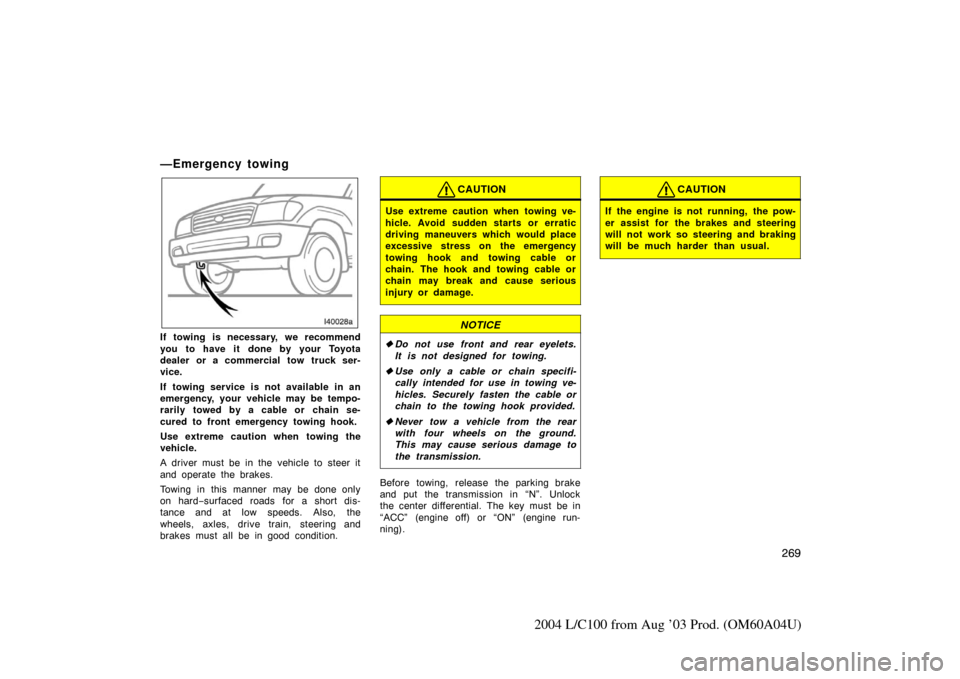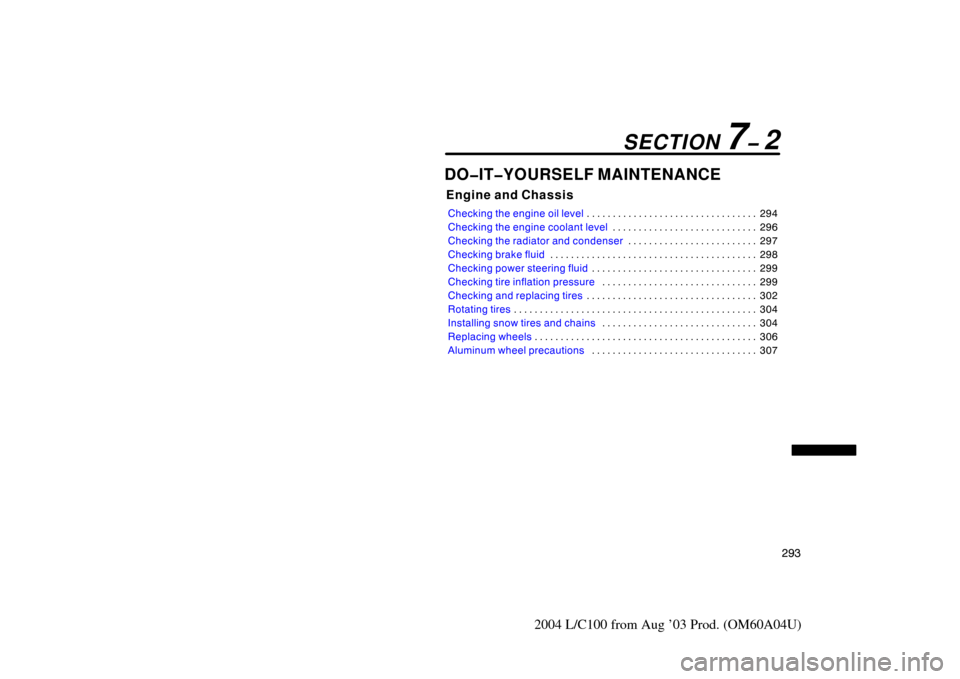Page 277 of 342

269
2004 L/C100 from Aug ’03 Prod. (OM60A04U)
—Emergency towing
If towing is necessary, we recommend
you to have it done by your Toyota
dealer or a commercial tow truck ser-
vice.
If towing service is not available in an
emergency, your vehicle may be tempo-
rarily towed by a cable or chain se-
cured to front emergency towing hook.
Use extreme caution when towing the
vehicle.
A driver must be in the vehicle to steer it
and operate the brakes.
Towing in this manner may be done only
on hard−surfaced roads for a short dis-
tance and at low speeds. Also, the
wheels, axles, drive train, steering and
brakes must all be in good condition.
CAUTION
Use extreme caution when towing ve-
hicle. Avoid sudden starts or erratic
driving maneuvers which would place
excessive stress on the emergency
towing hook and towing cable or
chain. The hook and towing cable or
chain may break and cause serious
injury or damage.
NOTICE
� Do not use front and rear eyelets.
It is not designed for towing.
� Use only a cable or chain specifi-
cally intended for use in towing ve-
hicles. Securely fasten the cable or
chain to the towing hook provided.
� Never tow a vehicle from the rear
with four wheels on the ground.
This may cause serious damage to
the transmission.
Before towing, release the parking brake
and put the transmission in “N”. Unlock
the center differential. The key must be in
“ACC” (engine off) or “ON” (engine run-
ning).
CAUTION
If the engine is not running, the pow-
er assist for the brakes and steering
will not work so steering and braking
will be much harder than usual.
Page 291 of 342

283
2004 L/C100 from Aug ’03 Prod. (OM60A04U)
Exhaust system
If you notice any change in the sound of
the exhaust or smell exhaust fumes, have
the cause located and corrected immedi-
ately. (See “Engine exhaust cautions” on
page 211.)
INSIDE THE VEHICLE
Items listed below should be checked
regularly, e.g. while performing periodic
services, cleaning the vehicle, etc.
Lights
Make sure the headlights, stop lights, tail
lights, turn signal lights, and other lights
are all working. Check headlight aim.
Service reminder indicators and warning
buzzers
Check that all service reminder indicators
and warning buzzers function properly.
Steering wheel
Be alert for changes in steering condition,
such as hard steering or strange noise.Seats
Check that all front seat controls such as
seat adjusters, seatback recliner, etc. op-
erate smoothly and that all latches lock
securely in any position. Check that the
head restraint move up and down smooth-
ly and that the locks hold securely in any
latched position. For folding
−down rear
seatbacks, swing −up rear seat cushions
and detachable third seats, check that the
latches lock securely.
Seat belts
Check that the seat belt system such as
buckles, retractors and anchors operate
properly and smoothly. Make sure the belt
webbing is not cut, frayed, worn or dam-
aged.
Accelerator pedal
Check the pedal for smooth operation and
uneven pedal effort or catching.
Brake pedal
Check the pedal for smooth operation and
that the pedal has the proper clearance.
Check the brake booster function.
Brakes
At a safe place, check that the brakes do
not pull to one side when applied. Parking brake
Check that the lever has the proper travel
and that, on a safe incline, your vehicle
is held securely with only the parking
brake applied.
Automatic transmission “Park” mecha-
nism
Check the lock release button of the se-
lector lever for proper and smooth opera-
tion. On a safe incline, check that your
vehicle is held securely with the selector
lever in “P” position and all brakes re-
leased.
OUTSIDE THE VEHICLE
Items listed below should be performed
from time to time, unless otherwise
specified.
Fluid leaks
Check underneath for leaking fuel, oil, wa-
ter or other fluid after the vehicle has
been parked for a while. If you smell fuel
fumes or notice any leak, have the cause
found and corrected immediately.
Doors and engine hood
Check that all doors and back door oper-
ate smoothly and all latches lock securely.
Make sure the engine hood secondary
latch secures the hood from opening when
the primary latch is released.
Page 301 of 342

293
2004 L/C100 from Aug ’03 Prod. (OM60A04U)
DO�IT�YOURSELF MAINTENANCE
Engine and Chassis
Checking the engine oil level294
. . . . . . . . . . . . . . . . . . . . . . . . . . . . . . . . .
Checking the engine coolant level 296
. . . . . . . . . . . . . . . . . . . . . . . . . . . .
Checking the radiator and condenser 297
. . . . . . . . . . . . . . . . . . . . . . . . .
Checking brake fluid 298
. . . . . . . . . . . . . . . . . . . . . . . . . . . . . . . . . . . . \
. . . .
Checking power steering fluid 299
. . . . . . . . . . . . . . . . . . . . . . . . . . . . . . . .
Checking tire inflation pressure 299
. . . . . . . . . . . . . . . . . . . . . . . . . . . . . .
Checking and replacing tires 302
. . . . . . . . . . . . . . . . . . . . . . . . . . . . . . . . .
Rotating tires 304
. . . . . . . . . . . . . . . . . . . . . . . . . . . . . . . . . . . . \
. . . . . . . . . . .
Installing snow tires and chains 304
. . . . . . . . . . . . . . . . . . . . . . . . . . . . . .
Replacing wheels 306
. . . . . . . . . . . . . . . . . . . . . . . . . . . . . . . . . . . . \
. . . . . . .
Aluminum wheel precautions 307
. . . . . . . . . . . . . . . . . . . . . . . . . . . . . . . .
SECTION 7� 2
Page 333 of 342
325
2004 L/C100 from Aug ’03 Prod. (OM60A04U)
BRAKES
Minimum pedal clearance when depressed
with the force of 490 N (50 kgf, 110 lbf)
with the engine running, mm (in.): 116 (4.6)
Pedal free play, mm (in.): 1—6 (0.04—0.24)
Pad wear limit, mm (in.):
1.0 (0.04)
Lining wear limit, mm (in.): 1.0 (0.04)
Parking brake adjustment when pulled with
the force of 196 N (20 kgf, 44 lbf): 4—6 clicks
Fluid type: SAE J1703 or FMVSS No.116 DOT 3
STEERING
Wheel free play: Less than 40 mm (1.6 in.)
Power steering fluid type: Automatic transmission fluid DEXRON
\bII
or III
Page 336 of 342

328
2004 L/C100 from Aug ’03 Prod. (OM60A04U)
26. HEAD (LH�LWR) 10 A: Left−hand head-
light (low beam)
27. HEAD (RH�UPR) 20 A: Right−hand
headlight (high beam)
28. HEAD (LH�UPR) 20 A: Left−hand head-
light (high beam)
29. PWR OUTLET 15 A: Power outlets
30. CIG 15 A: Cigarette lighter
31. ACC 7.5 A: Instrument panel light
32. AM1 7.5 A: Multiport fuel injection sys-
tem/Sequential multiport fuel injection
system
33. DEFOG 20 A:
Rear window defogger
34. AHC�B 15 A: Active height control sus-
pension (AHC)
35. FUEL HTR 20 A: Fuel heater
36. POWER HTR 7.5 A: Power heater
37. AHC�IG 20 A: Active height control sus-
pension (AHC)
38. EFI or ECD No.2 10 A: Emission control
system
39. GAUGE1 10 A: Gauges and meters
40. ECU�IG1 10 A: Multiport fuel injection
system/S equential multiport fuel injec-
tion system
41. ECU�B1 10 A:
Navigation system
42. DBL LOCK 15 A: Double lock system
43. BATT CHARGE 30 A
44. A/C 15 A:
Air conditioning system
45. STOP 15 A: Stop lights
46. OBD�2 7.5 A: On−board diagnosis system
47. IDEL UP 7.5 A: Idle−up system
48. LH SEAT 30 A: Power seat system
49. DOOR 25 A: Power door lock system,
Power windows
50. SUN ROOF 25 A: Electronic moon roof
51. RR WIPER 15 A: Rear wiper system
52.ECU�B2 10 A: Power door lock system,
Power window
53. DIFF 20 A: Four−wheel drive system
54. WASHER 15 A: Windshield washer
55. RADIO 10 A: Audio system
56. DOME 10 A: Interior lights
57. VGRS 40 A: Variable gear ratio steer-
ing system
58. P/W (FL) 20 A: Power window
59. P/W (RL) 20 A: Power window
60. WIPER 25 A: Windshield wiper
61. ECU�IG2 10 A: Rear air conditioning
system
62. SEAT HTR 15 A: Seat heater 63. GAUGE2 10 A:
Back−up lights
64. MET 7.5 A: Gauges and meters
65. IGN 7.5 A: Multiport fuel injection sys-
tem/Sequential multiport fuel injection
system
66. SECURITY 7.5 A: Theft deterrent sys-
tem
67. P/W (RR) 20 A: Power window
68. P/W (FR) 20 A: Power window
69. TIL&TEL 20 A: Tilt and telescopic
steering
70. RR A/C 30 A: Rear air conditioning
system
71. RH SEAT 30 A: Power seat system
Page:
< prev 1-8 9-16 17-24